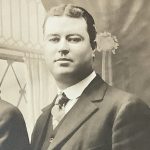Sepia Saturday 544. Fifteenth in a series about Albert Barney Charboneau — my paternal grandfather’s brother who died in the Great Influenza Pandemic of 1918.

My dad’s Uncle Albert Barney Charboneau, fell ill in October 1918 when the second wave of the deadly pandemic influenza, which had spread around the globe, reached his hometown of Dolgeville, Herkimer Co., N.Y.
At 33, Albert was the woodworking foreman at the Julius Breckwoldt piano sounding board factory and the head of the Dolgeville Mason’s lodge.
He had been married for six years to Annie (Miller) Charboneau — and he was a tall, robust man one would not expect to get sick, let alone die. Yet Albert’s age and profile put him at risk in the 1918 pandemic.

The influenza’s virulent impact
In her book Flu: The Story of the Great Influenza Pandemic of 1918 and the Search for the Virus That Caused It, author Gina Kolata sums up the sweep and toll of the influenza’s deadly second wave. 1 Kolata, Gina. Flu: The Story of the Great Influenza Pandemic of 1918 and the Search for the Virus That Caused It. (Farrar, Straus and Giroux:New York, 1999), 4-5.
The sickness preyed on the young and healthy.…The plague took off in September of that year, and when it was done over half a million Americans would lie dead. The illness spread to the most remote parts of the globe. Some Eskimo villages were decimated, and nearly eliminated from the face of the earth. Twenty percent of Western Samoans perished. No matter where it struck, the virus went after an unusual group — young adults who are generally spared the ravages of infections diseases. The death curves were W-shaped, with peaks for the babies and toddlers under age 5, the elderly who were aged 70-74, and people aged 20-40. 2 Kolata, Flu,4-5.

Lethal curve of the 1918 influenza
Nor was Uncle Albert alone. As shown in the table below, he contracted the 1918 influenza during a peak fatality period in the U.S. armed forces. Like him, the soldiers and sailors who were mobilized/demobilized in huge numbers during WWI were in the vulnerable 20-40 age group.
| U.S. Army in the U.S. – Deaths Due to Influenza and Pneumonia in 1918 – Source: Alfred W. Crosby America’s Forgotten Pandemic 3 Crosby, Alfred W. America’s Forgotten Pandemic: The Influenza of 1918 (Cambridge: Cambridge University Press, 2003), 59. | ||
| For the Week ending: | ||
| 10 | September | 98 |
| 27 | September | 972 |
| 4 | October | 2,444 |
| 11 | October | 6,170 |
| 18 | October | 5,559 |
| 27 | October | 2,624 |
| 1 | November | 1,183 |
| 8 | November | 908 |
| 15 | November | 519 |
| 22 | November | 321 |
Civilian casualties climb
The curve of the 1918 influenza in the civilian population mirrored the military experience — although cities that took containment measures, and encouraged mask wearing and social distancing, fared better than those that did not.
All told, 195,000 people died of influenza in the U.S. during October, when the second wave peaked, according to the 1918 Pandemic Influenza Historic Timeline on the Centers for Disease Control (CDC) website.
Sadly, my dad’s Uncle Albert was among those casualties, succumbing to the influenza on 23 October 1918 — 102 years ago this month.
He died before my dad was born. So the few details I know about his final days are contained in his obituaries — which will be reviewed in the next post.
Please stop back. Meanwhile, please visit the blogs of this week’s other Sepia Saturday participants .here
© 2020 Molly Charboneau. All rights reserved.
